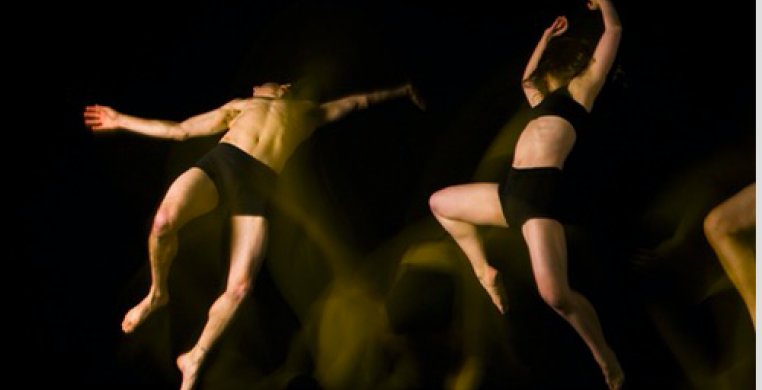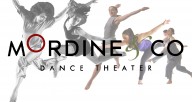Instead of the gut-curdling screech of tires and crunch of metal on metal, the gentle sounds of Mordine and Company’s “Collisions,” premiering at Links Hall this Thursday through Sunday, May 25, 26, and 27, soothe and comfort on a quiet island of hope amidst today’s brash noise of global conflict. Instead of mayhem and destruction, the impact of these tender collisions, between individuals, between dance styles, between cultures, distills the differences of humanity into a molten unity. Flow is the dominant characteristic of stage energy throughout the compact, thoroughly engaging program.
Shirley Mordine set the evening’s tone with a typically warm, laid-back welcome introducing an opening video montage of choreographic excerpts documenting the fruitful collaborative history of Mordine and Company and Natya Dance Theatre. The video features three works: “Two Rivers,” a snippet from the duet, “Sahridaya,” and “Push to the Edge,” all jointly-choreographed by Mordine and Natya Artistic Director Hema Rajagopalan. The two artistic directors detailed their newest collaboration, “Collisions,” launched on their recent trip to India to work on their MacArthur-funded International Exchange project with Indian choreographer Astad Deboo. The project will culminate in collaborative workshops at the Dance Center of Columbia College and performances this coming August.
Following the video, Mordine and Company’s Melissa Pillarella and Natya’s Asha Rowland gave a live performance of the complete “Sahridaya” (empathy). Pillarella, in western tights and tunic, and Rowland in traditional Indian dress, begin in speculative query of each other. Rowland’s Bharata Natyam-inspired flexed wrists and ankles, articulated fingers, and accented heel-toe stomps contrast the swoop and dive of Pillarella’s breathy modern dance, but the two styles converge in strong diagonal body planes. They grow increasingly available to one another’s movement in a charmingly-danced cross-pollination of personalities and styles that mirror each other, come together, separate, and ultimately agree to be both together and uniquely oneself.
A full-company open improvisation introduced us to the creative process behind Mordine’s direction and choreographic invention. “I encourage the dancers to imitate each other, different from copying which is literal, as a tool for perceiving each other,” Mordine explained while the dancers changed costumes between pieces. The improvisation will take place each night with a different musician. On Thursday, Barry Bennet used synthesizer, his own amplified voice, and electronic keyboard to create a sound-scape with the dancers. Uncanny sensitivity to each other’s energy and movement impulses is at the heart of perception for these individuals. A constant ebb and flow of energy ignited wide leg arcs, small, effortless jumps, and a naturalness that brought out the unique movement qualities of each in a completely collaborative spirit. Bennet’s haunting, intuitive sounds partnered the dancers as if composed explicitly for their enchanting invention of corkscrew twists, tumbling turns, and quietly electric connectedness, all fascinating and somehow meditative, but never sedative.
“Collisions,” the first installment of the MacArthur-funded collaboration between Mordine and Company and Natya Dance Theatre, inspires a host of thoughts on conflict resolution, and how many fascinating ways the human body can tumble, fold, lift, wrap, reach, stomp, twist, and fall in and out of connection. It was all the more interesting to see “Collisions,” performed after the open improvisation, because you could recognize the underpinnings of the group’s improvisational process informing the clearly evolved and more fully-designed movement logic of the choreographed work. Bodies working off bodies, touching and not touching, convening and splitting apart, balancing on each other, falling into one another and separating in a softly comforting series of encounters. How can hand-springs be soft? And yet the spinning orbits of these dancers created a continuum of comfort and ease with rich dynamic variety that kept the senses alert with a host of delightful surprises, like the reverse partnering of women carrying men.
The dancers’ moving shadows in and out of Monica Thomas' black and white projected images of static human silhouettes at the end of the piece heightened suspense for something yet to happen, and then it just keeps happening in “Collision’s” zen-like world of convening and diffusing.
Mordine’s fine-tuned use of silence and music—Vijay Iyer’s intense jazz pulse and Fred Simon’s contrasting commissioned score of chimes, percussive echoes, bells, and temple blocks—brought a fluid aesthetic to the whole of “Collisions.” Unlike western music, as Mordine stated after final bows, she wanted to take the movement “to a different, and a different, and a different place, without beginning, middle, or end.” And she does!
For tickets and details, go to seechicagodance.com, and click on "Upcoming Events."



